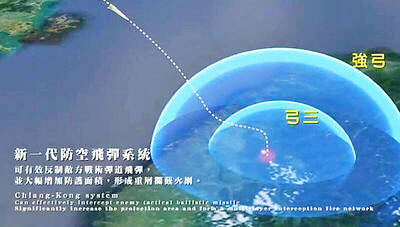Floods blocked roads in southern China, leaving some 300 teenagers stranded at a school with limited supplies of food and water, an official said yesterday, after days of heavy rain killed at least 16 people.
More than 320,000 people have fled their homes in southern and central China after heavy rains toppled houses, flooded roads and damaged a dam, news reports said.
Flood waters blocked the entrances to the Hemu Town Middle School in the Guangxi region and rendered nearby roads impassable, said an official in Rongshui County, where the school is situated. She would only give her surname, Lu.
CCTV said floodwaters along a major commercial thoroughfare elsewhere in Rongshui were more than 2.5m deep. The report said it was the highest water level the county has seen in a decade.
Flood control officials used boats to deliver food, mineral water and other supplies to the school on Saturday, including pumps to lower the water level, Lu said.
She said she did not know how long the children, aged from 13 to 15 years, had been stuck in the building.
Heavy rains have battered the region since Wednesday. By Friday, 80 percent of the county was inundated, causing the Rongjiang River to overflow its banks and forcing the relocation of more than 70,000 people, Lu said.
CCTV showed flooded Rongshui streets, where the signboards of restaurants and shops were all that could be seen above the water. Mattresses, household items and other debris drifted in the water.
The county government estimated the damage at 210 million yuan (US$31 million), Xinhua news agency reported.
The rain also destroyed a 13m section of a dike near the base of the Kama Reservoir in Guangxi, Xinhua said.
About 15,000 people who lived downstream from the dam were moved to safety and were now living in more than 1,000 tents, the national flood control office said in a statement on Saturday.
In the central province of Hunan, floods have killed eight people and forced 140,000 to relocate. Five people have died in southeastern Fujian Province, two others were missing, and 22,000 people have been evacuated, Xinhua said on Saturday.
Another three people died and four were missing in Jiangxi Province and in the Guangxi region another 80,000 people were forced from their homes.

LIMITS: While China increases military pressure on Taiwan and expands its use of cognitive warfare, it is unwilling to target tech supply chains, the report said US and Taiwan military officials have warned that the Chinese People’s Liberation Army (PLA) could implement a blockade within “a matter of hours” and need only “minimal conversion time” prior to an attack on Taiwan, a report released on Tuesday by the US Senate’s China Economic and Security Review Commission said. “While there is no indication that China is planning an imminent attack, the United States and its allies and partners can no longer assume that a Taiwan contingency is a distant possibility for which they would have ample time to prepare,” it said. The commission made the comments in its annual

DETERMINATION: Beijing’s actions toward Tokyo have drawn international attention, but would likely bolster regional coordination and defense networks, the report said Japanese Prime Minister Sanae Takaichi’s administration is likely to prioritize security reforms and deterrence in the face of recent “hybrid” threats from China, the National Security Bureau (NSB) said. The bureau made the assessment in a written report to the Legislative Yuan ahead of an oral report and questions-and-answers session at the legislature’s Foreign Affairs and National Defense Committee tomorrow. The key points of Japan’s security reforms would be to reinforce security cooperation with the US, including enhancing defense deployment in the first island chain, pushing forward the integrated command and operations of the Japan Self-Defense Forces and US Forces Japan, as

INTERCEPTION: The 30km test ceiling shows that the CSIST is capable of producing missiles that could stop inbound missiles as they re-enter the atmosphere Recent missile tests by the Chungshan Institute of Science and Technology (CSIST) show that Taiwan’s missiles are capable of intercepting ballistic missiles as they re-enter the atmosphere and pose a significant deterrent to Chinese missile threats, former Hsiung Feng III missile development project chief engineer Chang Cheng (張誠) said yesterday. The military-affiliated institute has been conducting missile tests, believed to be related to Project Chiang Kung (強弓) at Pingtung County’s Jiupeng Military Base, with many tests deviating from past practices of setting restriction zones at “unlimited” and instead clearly stating a 30.48km range, Chang said. “Unlimited” restrictions zones for missile tests is

PUBLIC SAFETY: The nationwide distribution campaign aims to enhance society’s overall understanding of threats and bolster defense awareness, an official said The latest edition of the National Public Safety Guide is being mailed to all citizens starting today to foster public awareness of self-defense in the event of war or natural disasters, the Ministry of National Defense said yesterday. “The guides will be disseminated to the public to enhance society’s overall understanding of threats and bolster defense awareness, demonstrating the government’s emphasis on people’s safety and its determination to pursue self-defense,” All-out Defense Mobilization Agency Director Shen Wei-chih (沈威志) said at the ministry’s news conference. The nationwide distribution campaign was planned according to President Lai William’s (賴清德) Sept. 20 directive, he said, adding